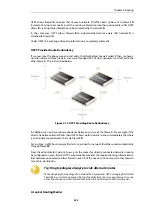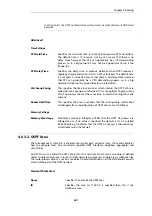
Note that
SAT
rules do not need to take into account that there are more organizations
connected to the same physical unit. There is no direct connection between them; everything
arrives through the same interface, connected to the
main
routing table. If this was done without
virtual routing, the
Allow
rules would have to be preceded by
NAT
rules for traffic from other
organizations. Care would also have to be taken that such rules were in accordance with the
security policy of each organization. Such problems are eliminated with virtual routing.
The source interface filters are very specific.
Any
is not used as the source interface anywhere,
since such a rule would trigger regardless. Consider for instance what would happen if the
vs1-http-in
rules were to use
Any
as source interface. They would trigger as soon as packets
destined to
pubip-vs1
were received on
main-ext
. The destination address would be rewritten to
192.168.0.5
, and passed on using the main routing table. The main routing table would not know
what to do with
192.168.0.5
and pass it back out to the default gateway outside the NetDefend
Firewall.
If the same naming scheme as shown in this example is used, making sure the source interfaces
are correct can be done quickly. All the rules concerning the
main
system have source interfaces
beginning with "
main-
". All those concerning
vs1
have source interfaces beginning with "
vs1-
",
and so on.
The destination interface filters, however, do not need to be as specific as the source interface
filters. The possible destinations are limited by the routing tables used. If the
vs1
table only
includes routes through
vs1-
interfaces,
Any
filters can only mean "through other interfaces in the
same virtual system". It may however be sound practice to write tighter destination interface
filters in case an error occurs elsewhere in the configuration. In this example, rule 1 might use
main-ifs
, rule 4 might use
vs1-main
. The
SAT
and corresponding
Allow
rules however are already
fairly tight in that they only concern one single destination IP address.
4.5.5. Multiple IP rule sets
An alternative approach to having all the IP rules for different virtual systems in one rule set is to
make use of
Multiple IP rule sets
.
Although all scanning of IP rules begins in the
main
rule set, it is possible to define a rule in
main
whose action is
Goto
so that scanning continues in a separate, named rule set. These extra rule
sets can be defined as needed and one rule set can be created for each virtual system and its
corresponding routing table.
More details on this subject can be found in
Section 3.6.4, “Multiple IP Rule Sets”
.
4.5.6. Trouble Shooting
When setting up virtual routing, the following steps can help with troubleshooting any
problems.
•
Make sure that the source interface filters are correct
•
Double check interface PBR table membership, for all types of interfaces and tunnels.
•
Use "ping -p <pbrtable>" to source pings from different virtual systems.
•
Use "ping -r <recvif> -s <srcip>" to test the rule set, simulating that the ping was received on
a given interface from a given IP address.
•
Use "arpsnoop -v <ifacenames>" to get verbose information about ARP resolution.
•
Use "route <pbrtable> -all" to view all route entries in a given table, including "core" routes.
•
Use "route -lookup <ipaddr> <pbrtable>" to make sure that a given IP address is routed the
Chapter 4: Routing
329
Содержание NetDefendOS
Страница 30: ...Figure 1 3 Packet Flow Schematic Part III Chapter 1 NetDefendOS Overview 30 ...
Страница 32: ...Chapter 1 NetDefendOS Overview 32 ...
Страница 144: ...Chapter 2 Management and Maintenance 144 ...
Страница 220: ... Enable DHCP passthrough Enable L2 passthrough for non IP protocols 4 Click OK Chapter 3 Fundamentals 220 ...
Страница 267: ... SourceNetwork lannet DestinationInterface any DestinationNetwork all nets 4 Click OK Chapter 3 Fundamentals 267 ...
Страница 284: ...Chapter 3 Fundamentals 284 ...
Страница 360: ...The ospf command options are fully described in the separate NetDefendOS CLI Reference Guide Chapter 4 Routing 360 ...
Страница 392: ...Chapter 4 Routing 392 ...
Страница 396: ...Web Interface 1 Go to Network Ethernet If1 2 Select Enable DHCP 3 Click OK Chapter 5 DHCP Services 396 ...
Страница 419: ... Host 2001 DB8 1 MAC 00 90 12 13 14 15 5 Click OK Chapter 5 DHCP Services 419 ...
Страница 420: ...Chapter 5 DHCP Services 420 ...
Страница 424: ...2 Now enter Name lan_Access Action Expect Interface lan Network lannet 3 Click OK Chapter 6 Security Mechanisms 424 ...
Страница 573: ...Chapter 6 Security Mechanisms 573 ...
Страница 575: ...This section describes and provides examples of configuring NAT and SAT rules Chapter 7 Address Translation 575 ...
Страница 607: ...Chapter 7 Address Translation 607 ...
Страница 666: ...Chapter 8 User Authentication 666 ...
Страница 775: ...Chapter 9 VPN 775 ...
Страница 819: ...Chapter 10 Traffic Management 819 ...
Страница 842: ...Chapter 11 High Availability 842 ...
Страница 866: ...Default Enabled Chapter 13 Advanced Settings 866 ...
Страница 879: ...Chapter 13 Advanced Settings 879 ...








































